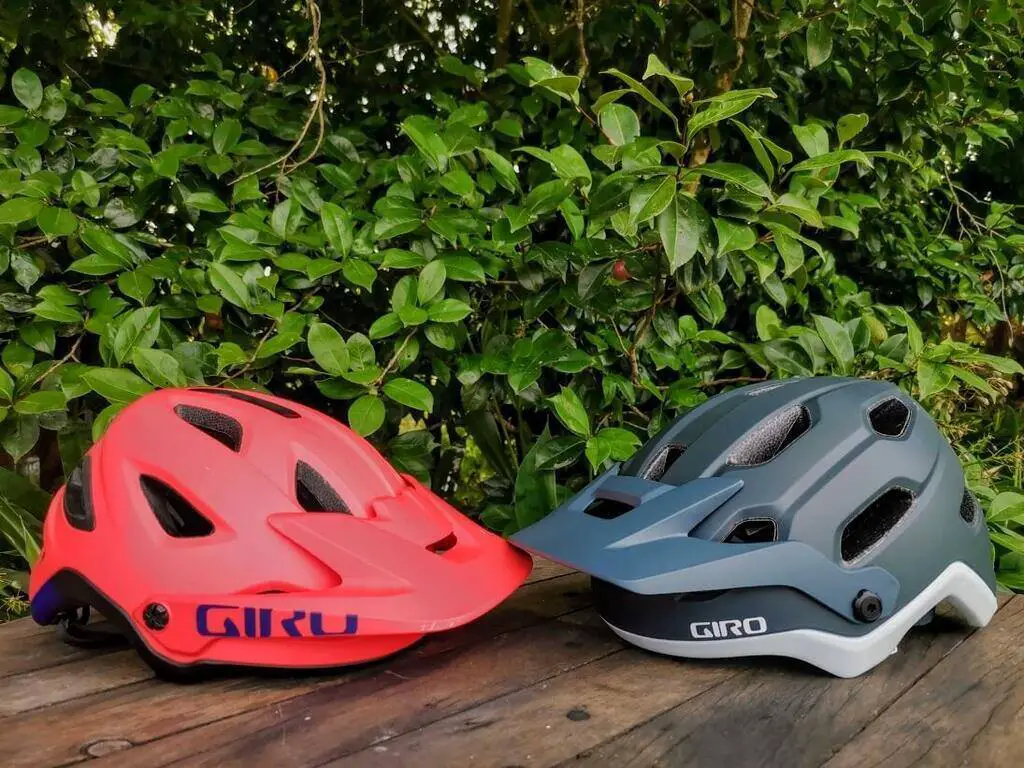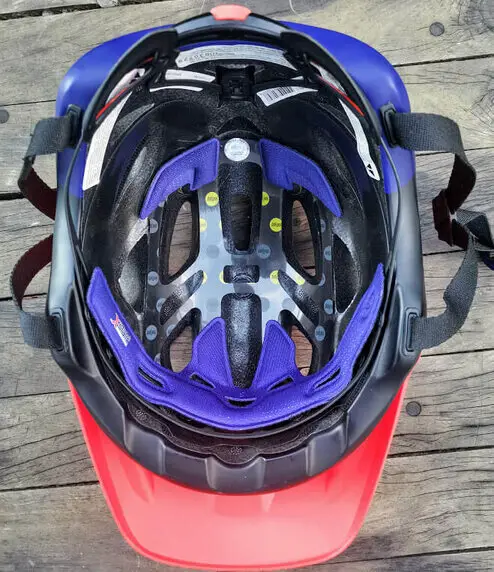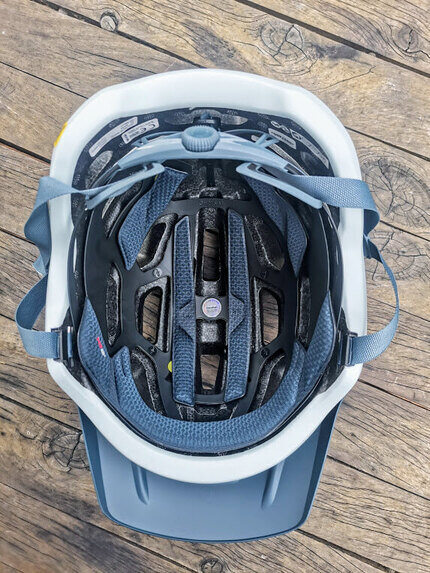We will look in-depth at the Giro Montaro vs Giro Source. While both are excellent helmets by the reputable bike brand, Giro, there are some differences between these helmets that may make you want to select one over the other.
The Montaro is the higher-spec of the two. It has additional features, but that also means it also has a higher price than the Source. In this post, we will look into whether the Montaro is worth the extra penny for you or if you are better with the Source!
Both mountain bike helmets are designed for trail riders, from beginners through to advanced riders. Both are lightweight, well-ventilated options, with adjustable visors and high-end fitting systems. They are actually fairly similar helmets, but we will dive deeper into the differences below.
Giro Montaro Mini Review
One of the top-of-the-line helmets from Giro, made for trail riders who want all the features and to look good while shredding up the trails.
Pros
- MIPS technology
- Comfortable and highly adjustable fit
- Adjustable visor
- Goggle Storage beneath visor and goggle grippers
Cons
- Padding wears out quickly
- Heavy and not as well ventilated considering its price range
The Montaro has been in the rankings for the best overall helmet for a few years now. It is protective, comfortable, and looks really, really nice. It is also a very feature-rich helmet, where pretty much everything has been thought of!
Giro Source Mini Review
Designed to have all the features you need, with great ventilation and comfort, without bumping the price up with unnecessary features. Perfect for the all-mountain rider not wanting to make any sacrifices!
Pros
- MIPS Technology
- Comfortable and highly adjustable fit
- Adjustable visor
- Goggle Storage below the visor
Cons
- Ventilation not as good as Montaro
- Fewer features than the Montaro
It is clear a lot of thought went into the design of the Source. The shape and the comfort of the helmet are incredible, and so is the safety and the fit. It is an ideal helmet for someone wanting a good trail helmet, which prioritizes comfort and safety overweight and ventilation.
Construction Comparison
The primary difference between the design of the two helmets is the difference in coverage. The Source has more coverage around the back of the head and over the temples. While this does add a little more bulk to the helmet, it increases the protection the helmet offers.
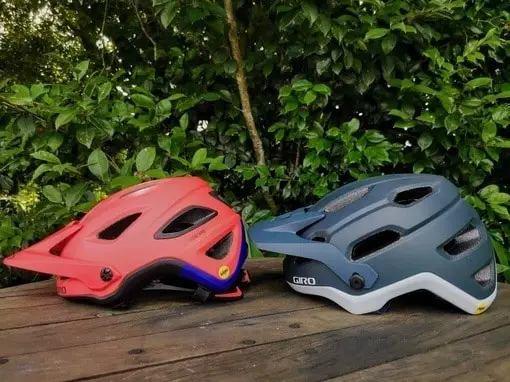
Both the Montaro and the Source are constructed using in-mold technology. What this means is the outer shell is molded to the EPS foam (Expanded Polystyrene) to increase the strength and durability of the helmet without increasing the weight.
Both visors are adjustable, but there is a difference. The Montaro visor moves in incremented steps. So, there are 3 set positions, while the Source doesn’t have incremented steps but has infinite positions. I prefer the Source visor as it allows you complete freedom around where the visor is placed, and it is much easier to adjust using one hand. I found adjusting the visor while riding with the Montaro not all that easy (although I suppose it could become easier as the incremented notches wear down a little).
The visor on the Montaro is a little longer than the visor on the Source. This isn’t really a good nor bad thing, so it is really up to personal preference as to whether you like the look or not (see our post on visors here).The benefits of having a longer visor include having greater protection from the sun or low hanging branches, but it does catch a little more wind if you were worried about being aero!
Fit Comparison
The fitting system of both helmets is REALLY good when considering the Giro Montaro vs Giro Source. The Montaro uses the slightly higher spec model of Giro’s Roc Loc system, called the Roc Loc 5 Air. This differs from the Source’s Roc Loc 5 as it keeps the shell of the helmet slightly away from the fitting system. This is done to allow air to flow over the top of the rider’s head and give a bit more flexibility in sizing as there is room to move between the retention system and the shell.
I found that the Montaro sits a bit higher on my head than the Source. As you can see in these photos, the Source sat deeper on my head while the Montaro sits quite high.

Giro Montaro 
Giro Source
Design Comparison
The Montaro does look like the more expensive MTB helmet. The finish looks really good due to the polycarbonate shell wrapping around a few of the vents (where the goggle grips and the integrated camera mount are) as well as the base of the helmet, down to the really small details on the straps. The rubberized Giro logo is stitched onto the straps, and you don’t have any excess straps floating around as it is tied up in the strap system.
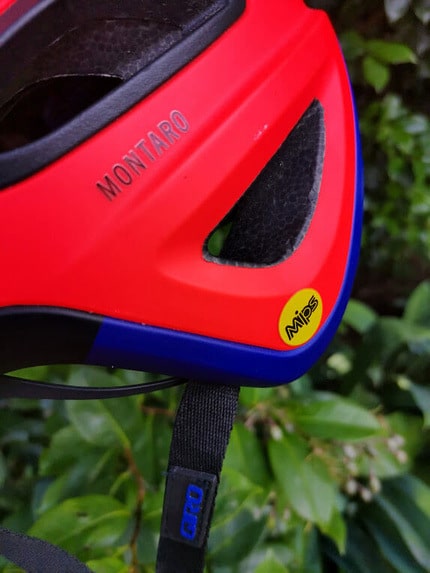
The Source also looks really good. Having a fully wrapped shell (none of the foam around the base of the helmet is exposed) not only helps protect the foam from wear and tear, it also gives it a clean and professional look.
While the color schemes of the Source are nice (I particularly like the Grey color pictured here), the Montaro does have a greater range of color choices. There are so many options for the Montaro that you are bound to find one that you like or one to match your bike. There are also women’s specific coloring for both (the female version of the Montaro is called the Montara), and if you want to read more on women’s specific helmets, see here.
Safety Comparison
Both helmets feature the slip-plane technology MIPS. MIPS stands for Multi directional Impact Protection System, which reduces the possibility of brain damage occurring to the rider following an angled impact.
It does so by providing a separation between the rider’s head and the EPS foam liner of the helmet so that it can rotate relative to the rider’s head. This dissipates the energy from the angled impact, reducing the force felt by the brain. We consider slip-plane technology, such as MIPS, essential in helmets these days.
The Montaro has a roll cage reinforcement. This reinforcement is constructed of a lightweight but extremely strong material that is hidden in the EPS foam layer. This helps keep the helmet sturdy and able to withstand greater impacts than those without.
Both helmets have extended coverage around the back of the head and around the temples. This helps protect the head in an awkward or backward crash from damaging the skull or from sharp objects penetrating the head. The extended coverage from the Source is a little more than the coverage from the Montaro.
Comfort, Weight and Ventilation Comparison
The Source is more comfortable than the Montaro when looking into the Giro Montaro vs Giro Source. The padding is plusher, softer, and more luxurious. It fit very well, and it just felt good on my head- even with a ponytail sitting out the back.
This is not to say that the Montaro was uncomfortable, because it certainly was comfortable. The padding is not as thick, but it is placed strategically, so the wider points of your head don’t feel any pressure points.
The Montaro weighs around 370g for a size medium, while the Source weighs a little less at 340g for a size medium. Considering the price and target market of the Montaro, it does weigh a fair bit more than it should. The Source, on the other hand, is reasonably lightweight, consider the additional coverage it supplies, and its price.
Both helmets have 16 vents in total. However, the ventilation on the Montaro is ever so slightly better. This is due to the smaller shape of the helmet and the fitting system, which holds the shell slightly away from the rider’s head, allowing more air to flow.
Additional features
The Montaro does have a few extras. It has rubberized ‘strap gripper’ on the back of the helmet to help keep goggle straps positioned and is able to store goggles beneath the visor.
There is an integrated camera or light mount on the Montaro (you buy the camera mount separately, but the fitting is built into the helmet). This is particularly handy for night riding or filming any cool trails you end up on! For more information on camera mounts, check out our post here.
The Source has ability to stow goggles beneath the visor when they aren’t needed, but has neither the goggle grippers nor the integrated camera mount.
Both helmets have X-Static padding which is a silver lined, anti microbial padding to prevent odor build up. The padding in the Montaro, however, is a bit thinner and tend to deteriorate after a year or so of riding and washing these pads. A slight downside, but replacement pads can be purchased reasonably cheaply.
Final Remarks
If you are after a top tier trail helmet that is not only safe and durable but also comfortable to wear, both the Giro Montaro and Giro Source will exceed your expectations.
If you are after a no expense spared helmet, the Montaro is the better choice. It has so many features that you won’t be feeling like something is missing.
While the Montaro is technically better (it is a higher spec model after all), I prefer the fit and feel of the Giro Source. I don’t tend to ride with goggles or a camera/light, so the additional features are a bit unnecessary for me. However, these are super handy features if you do ride with goggles or a camera!
So basically, the Montaro is a bit fancier. But if you find you don’t need the fancy stuff, the Source is just as good at the fundamentals (protecting your head and keeping you comfy) and a bit cheaper!
One of the top-of-the-line helmets from Giro, made for trail riders who want all the features and to look good while shredding up the trails.
Designed to have all the features you need, with great ventilation and comfort, without bumping the price up with unnecessary features. Perfect for the all-mountain rider not wanting to make any sacrifices!
If you liked this Giro Montaro vs Giro Source comparison and want further reading, have a look at the full Montaro review here or the Giro Source review here.
For more comparisons, check out these posts:
